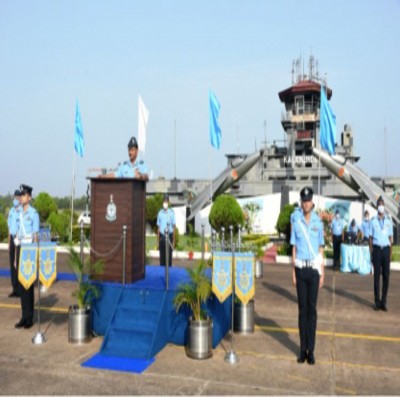
Kolkata, "All of you need to be conversant with your roles during actual operations. You need to be confident in operating the latest aircraft and systems inducted by the Indian Air Force (IAF)," Air Marshal D.K. Patnaik, Air Officer Commanding-in-Chief (AOC-in-C), Eastern Air Command, told the personnel of Air Force Station Kalaikunda in West Midnapore district of West Bengal during his four-day visit that ended on Friday.
The AOC-in-C was received by Air Commodore Ran Singh, Air Officer Commanding, Air Force Station Kalaikunda.
Surrounded by forests of Sal and Mahua, Air Force Station (AFS) Kalaikunda is located in a sleepy hamlet off National Highway 6 (old numbering) or National Highway 49 (as the stretch from Deoghar in Bihar to Kharagpur in West Bengal is now called). But action inside the gates of this air base is anything but sleepy. The growl of powerful jet engines greet visitors from a distance. The base is home to two squadrons of Hawk advanced jet trainers and this is one of the two locations in India where rookie pilots of the IAF receive their final round of operation conversion training before being assigned to fighter squadrons. The other location is Bidar in Karnataka.
But, there is more to AFS Kalaikunda than meets the eye. The base plays host to squadrons of Su-30 MKIs, Mirages, Mig-29s and the Tejas (as well as the last of the Mig-21 Bisons) as and when they require air-to-air practice with live munitions. Latest inductions of air-to-air missiles or rockets are also test-fired by fighter aircraft based out of AFS Kalaikunda. The air base has two ranges. One is an air-to-ground range at Dudhkundi. But, there are other air-to-ground ranges in the country as well, such as in Pokhran in Rajasthan. The unique thing that Kalaikunda offers is the air-to-air range over the Bay of Bengal.
"Training is a continuous process. Even the best of pilots needs to practice firing of missiles and cannons on a routine basis. This facility is offered only by AFS Kalaikunda. While pilots can carry out target practice with their cannons on banners carried behind aircraft designated for this job, missiles are fired at unmanned aerial vehicles developed as targets by the Defence Research and Development Organisation (DRDO). This is posible only at sea after notices are issued to civilian aircraft and merchant vessels. The Bay of Bengal, off the Digha coast, is considered the best location for this," a senior IAF official said.
Over the years, AFS Kalaikunda has played host to the air forces of several friendly countries who were keen to use these facilities and carry out aerial combat exercises with the IAF. Even the IAF benefitted from such exercises, with its aircraft operating alongside those from the United States Air Force, Royal Air Force and Republic of Singapore Air Force. They got to fly alongside the F-16 fighters that is in the inventory of one of India's not so friendly neighbours.
More importantly, AFS Kalaikunda operates as a staging point for both the northern border as well as the Andaman and Nicobar Islands. It would take less than an hour for fighter aircraft based at Kalaikunda to reach the Andamans in case of any eventuality. There are landing and maintenance facilities at Car Nicobar for such aircraft. Aircraft from Kalaikunda can also reach the Line of Actual Control (LAC) in Sikkim that falls within the Eastern Air Command's jurisdiction, in less than 30 minutes to provide support to air operations from AFS Hasimara. The air bases at Chhabua and Tezpur in Assam are primarily meant to counter any threat from across the LAC in Arunachal Pradesh.
During his visit to AFS Kalaikunda, Air Marshal Patnaik also inspected the base at Salua nearby. This is a very important IAF radar station that keeps track of all air traffic in the region.


.jpeg)

